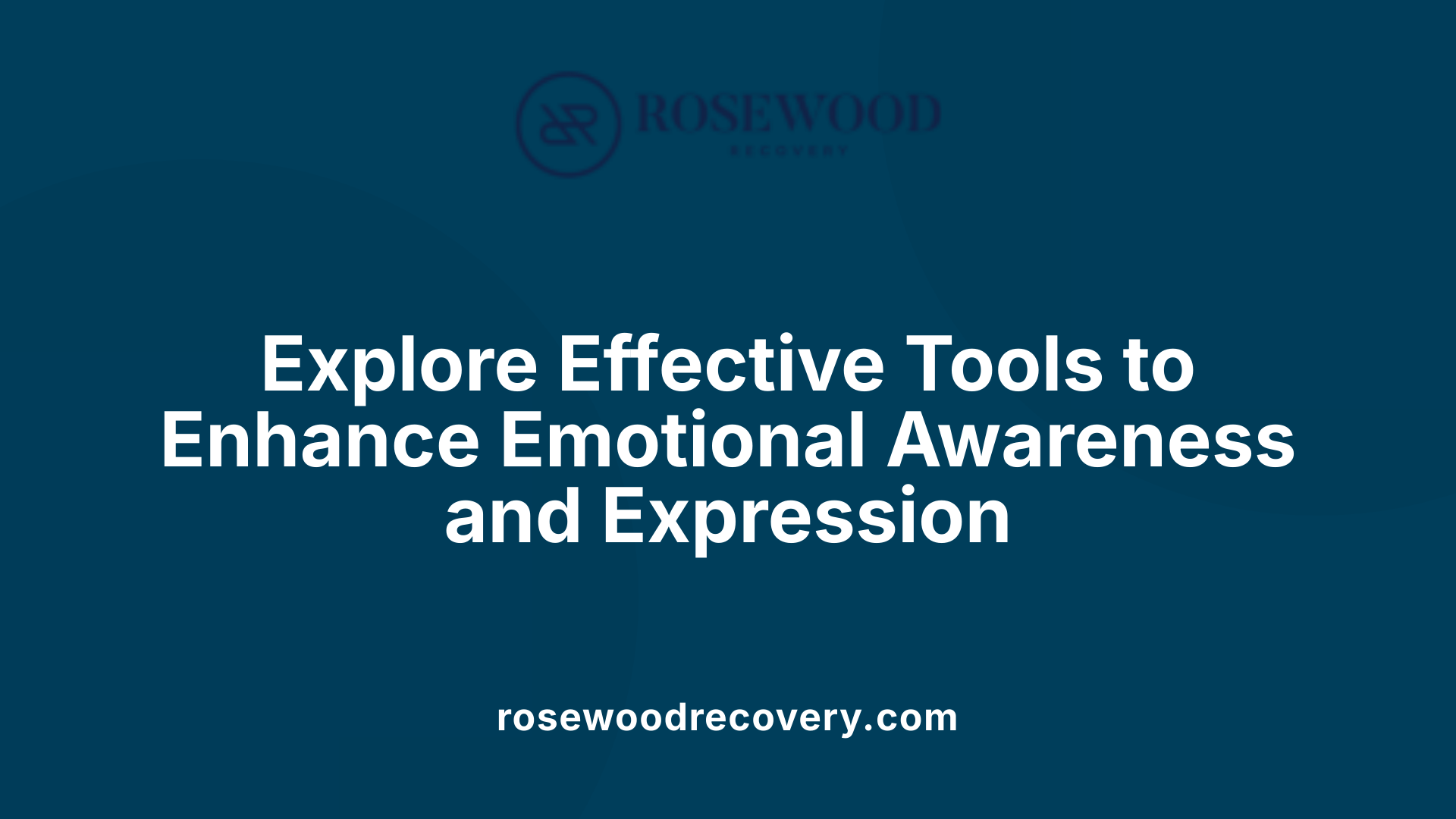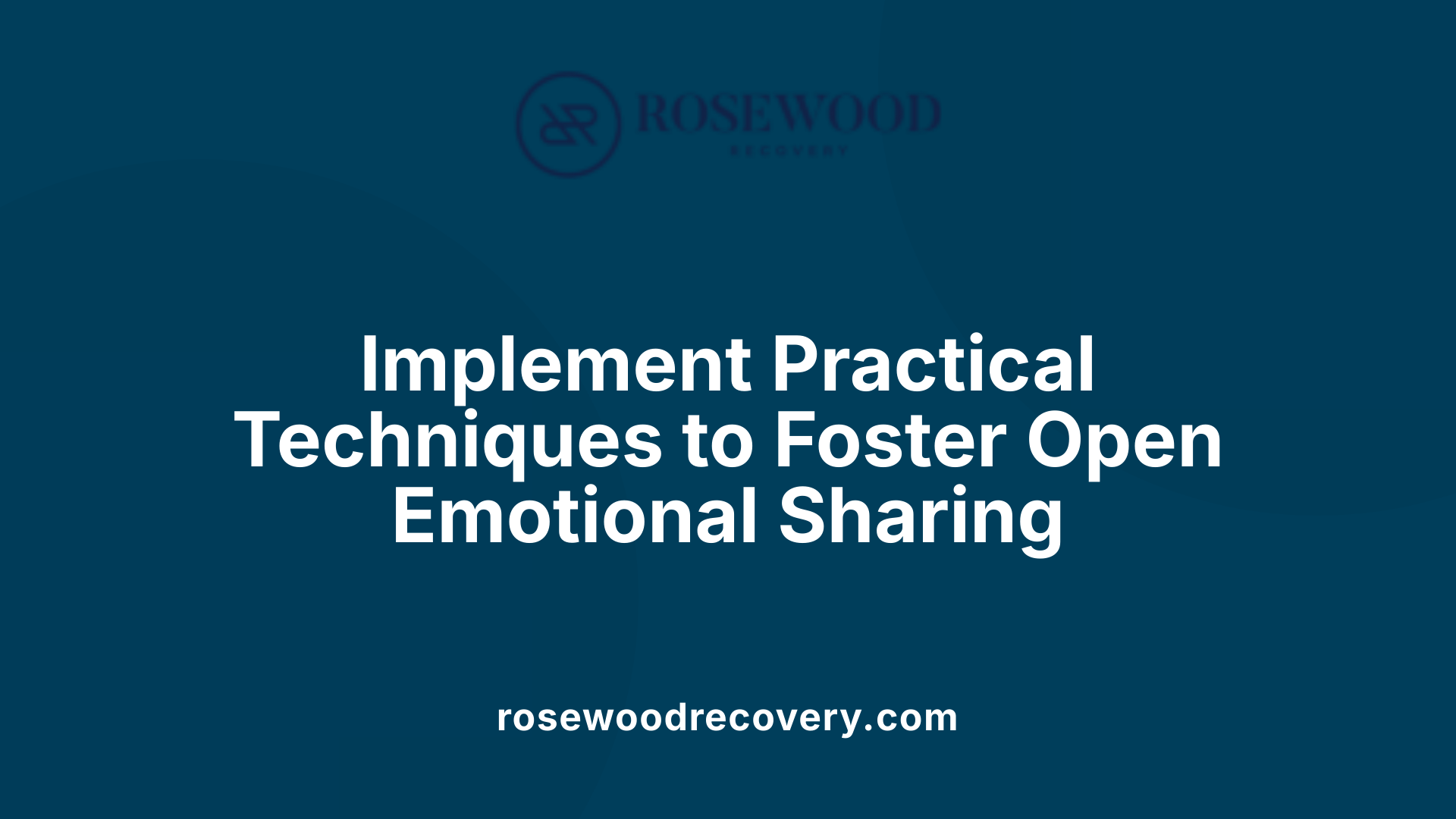How to express emotions safely in group therapy
Fostering Emotional Safety and Expression in Group Therapy

Creating a Foundation for Safe Emotional Sharing
Effective emotional expression in group therapy hinges on establishing a secure environment where participants feel valued, heard, and safe to share their vulnerabilities. This opening section explores the importance of environment, trust, and the role of facilitators in safeguarding emotional safety, setting the stage for meaningful therapeutic engagement.
Building a Supportive and Trusting Environment
How can an environment support emotional sharing and safety in group therapy?
Creating a space where clients feel comfortable and safe is essential for successful emotional sharing in group therapy. Such an environment is characterized by respect, confidentiality, and a genuine sense of support among members. Clear rules around confidentiality reassure participants that their personal disclosures will not be shared outside the group, fostering trust.
Boundaries are also vital. This includes establishing respectful listening, stating what is and isn't appropriate to share, and understanding the limits of emotional discussions. When boundaries are respected, members can open up without fear of judgment or intrusion.
Group cohesion plays a significant role. When members feel connected and accepted, they are more willing to share vulnerable feelings. Activities that foster connection, like mindfulness exercises or storytelling, enhance group bonds.
The facilitator or therapist is instrumental in managing the group's dynamics. They model respectful communication, manage conflicts appropriately, and ensure that everyone has a chance to participate. The therapist also guides the group in handling emotions constructively, which improves overall safety.
In addition, incorporating supportive practices such as active listening, expressing empathy, and encouraging shared experiences helps deepen trust. When participants know they are heard and understood, emotional openness becomes easier.
More Information Search Query: Creating a safe and supportive environment in group therapy for emotional sharing.
Guidelines and Best Practices for Emotional Sharing
What guidelines and best practices support emotional sharing in group therapy?
Creating a safe space is fundamental for meaningful emotional sharing in group therapy. Establishing a foundation of trust and confidentiality encourages members to open up without fear of judgment or repercussions. When participants feel secure, they are more likely to be honest and vulnerable about their feelings.
Active honest communication is another essential component. This involves expressing genuine emotions using specific language—like 'I feel...' statements—and providing sincere, non-judgmental feedback. Observing and responding to non-verbal cues, such as body language and facial expressions, enriches understanding and helps validate unspoken feelings.
Fostering a sense of shared experience by normalizing emotional struggles reduces shame and promotes empathy among members. Highlighting the here-and-now prompts self-awareness and reflection, encouraging members to articulate their current feelings and reactions.
Normalizing initial awkwardness and encouraging reflections on group dynamics help deepen bonds and understanding. This process emphasizes that difficulty in sharing feelings is common and manageable.
Incorporating theoretical frameworks, such as attachment theory, mentalization, and positive psychology, provides a broader context for understanding behaviors and emotions. These approaches support the development of secure attachments, enhance emotional understanding, and foster virtues like gratitude and resilience, all of which contribute to richer, more connected emotional exchanges.
Overall, consistent application of these guidelines nurtures an environment where trust, openness, and emotional growth can flourish, leading to more profound therapeutic benefits.
Managing Emotions and Maintaining Stability in Group Settings
What are some strategies for emotional regulation and communication within a group therapy setting?
Effective management of emotions in group therapy involves multiple interconnected techniques. First, psychoeducation about emotions helps participants understand feelings and their physical sensations, encouraging self-awareness. Techniques from therapies like Dialectical Behavior Therapy (DBT) and Acceptance and Commitment Therapy (ACT) emphasize mindfulness, cognitive reappraisal, and acceptance to help regulate intense feelings.
Participants are encouraged to identify and label their emotions accurately, which reduces avoidance and fosters openness. Relaxation methods such as deep breathing or grounding exercises serve to calm in-the-moment distress and prevent impulsive reactions.
Creating a supportive environment is crucial. Active listening, validation, and empathetic responses from group members promote safe expression and understanding. Modeling respectful behavior helps normalize emotional experiences, aiding members in developing healthier communication patterns.
Interpersonal emotion regulation (IER) strategies—like perspective-taking and offering support—enhance social connectedness and reduce emotional contagion, which can escalate group tensions. When conflicts arise, de-escalation techniques such as pausing, reframing, and gentle language are vital to maintain a calm atmosphere.
Overall, these approaches not only help individuals manage their feelings but also reinforce positive group dynamics, making the therapeutic setting a sanctuary for emotional growth. Consistent practice and fostering trust within the group enable lasting improvements in emotional regulation and interpersonal skills.
Tools and Resources to Support Safe Emotional Expression
 Supporting healthy emotional sharing in therapy and group settings often requires specific tools and resources that help individuals identify, process, and express their feelings effectively.
Supporting healthy emotional sharing in therapy and group settings often requires specific tools and resources that help individuals identify, process, and express their feelings effectively.
One highly useful tool is the emotion wheel, which categorizes various feelings and helps clients expand their emotional vocabulary. For example, Lindsey Braman’s Emotion Sensation Feeling Wheel provides insight into physical sensations associated with different emotions, enabling clients to recognize bodily cues and deepen their emotional awareness.
Journaling is another accessible resource that encourages reflection. By keeping regular emotion diaries or descriptive writing exercises, clients can slow down their emotional processing and gain clarity about their feelings. Journals serve as a private space for honest expression, fostering self-awareness and helping clients approach group discussions more confidently.
Creative outlets such as art, music, dance, poetry, and storytelling can be powerful methods for emotional expression. Engaging in these activities allows clients to explore feelings non-verbally, breaking the pressure to perfectly articulate emotions. Artistic pursuits provide safe and fulfilling ways to acknowledge and release strong feelings.
Mindfulness and relaxation exercises form a cornerstone of emotional regulation. Techniques like body scans, deep breathing, progressive muscle relaxation, and guided imagery help clients ground themselves, reduce anxiety, and create mental space for thoughtful emotional expression. These practices, when regularly incorporated, support clients in managing impulsive reactions and responding more intentionally.
In addition to these methods, various resources—including worksheets, self-compassion exercises, and guided discussions—assist clients in normalizing their feelings. Worksheets from positivepsychology.com, for example, facilitate emotional understanding, while self-compassion letters or affirmations promote kindness towards oneself during vulnerable moments.
Altogether, these tools foster an environment where clients feel equipped to share emotions safely and authentically. The integration of visual aids, creative activities, mindfulness practices, and therapeutic resources helps build confidence, deepen emotional awareness, and nurture resilient, expressive communication within group settings.
Therapeutic Approaches Facilitating Emotional Awareness and Management
How can therapeutic approaches facilitate understanding and management of emotions in group therapy?
In group therapy, various therapeutic methods work together to enhance emotional awareness and regulate feelings effectively. These approaches create a safe space where individuals can openly explore their emotions, recognize triggers, and share experiences without judgment.
One powerful technique is active listening, which helps members become more attentive to their own emotions and those of others. Role-playing activities, such as imagining conversations or using the empty chair method, allow clients to practice expressing feelings in a controlled environment. Mindfulness exercises, like body scans or deep breathing, teach members to observe emotions without immediately reacting, fostering internal awareness.
Among specific approaches, emotion-focused therapy (EFT) emphasizes understanding the emotional experience and transforming negative patterns. Similarly, Dialectical Behavior Therapy (DBT) provides skills in distress tolerance, emotional regulation, and interpersonal effectiveness, helping clients manage intense feelings like anger or sadness.
Cognitive-behavioral techniques help identify and reframe unhelpful thoughts that influence emotional responses, promoting healthier ways of coping. Social learning within the group also plays a crucial role. Peer feedback and modeling demonstrate adaptive reactions, teaching members new skills and reducing feelings of isolation.
These approaches not only deepen self-awareness but also foster empathy and connection among group members. As a result, individuals gain better insight into their emotions, learn to communicate more clearly, and develop resilience in handling emotional challenges.
By integrating these methods, group therapy becomes a comprehensive platform for emotional growth, where participants can practice skills in a supportive environment, leading to improved emotional regulation and healthier relationships outside the therapy setting.
Effective Techniques for Expressing Emotions and Managing Reactions
What are some techniques for effectively expressing emotions, like pausing and using 'I' statements?
One of the foundational methods for healthy emotional expression is the use of 'I' statements. These help communicate feelings directly and responsibly, reducing defensiveness and promoting understanding. For example, saying, "I feel overwhelmed when..." instead of blameful statements encourages open dialogue.
Pausing and breathing techniques are also vital. Taking a moment before responding—such as deep breathing, grounding exercises, or a short walk—can help calm emotional reactions and prevent impulsive remarks. This mindful pause allows individuals to process their feelings internally, leading to more thoughtful responses.
Creative outlets like art, music, or writing play a significant role in expressing complex emotions non-verbally. Engaging in dance, drawing, or poetry can evoke and process emotions safely, especially when verbal expression feels challenging.
Active listening is integral in emotional exchanges. Giving full attention, validating others' feelings, and reflecting back what has been heard fosters connection and encourages mutual openness. When everyone practices listening with empathy, sharing feelings becomes more comfortable and productive.
Combining these strategies—assertive communication, mindful pauses, creative activities, and attentive listening—creates a supportive environment where emotional expression is safe, clear, and constructive. These tools not only enhance personal awareness but also strengthen relationships through genuine, mindful connection.
Principles of Emotional Safety and Vulnerability

What principles underpin emotional safety and vulnerability in group therapy?
Creating an environment conducive to emotional safety and openness is fundamental in group therapy. Several core principles support this goal. First, establishing clear guidelines around confidentiality ensures that participants feel secure sharing personal feelings without fear of external judgment or repercussions.
Respectful boundaries are equally vital. These include respecting physical, emotional, spiritual, and intellectual limits, which prevents boundary violations and promotes a sense of autonomy among group members.
Validation of feelings is another essential principle. When all emotions—whether positive or challenging—are acknowledged and accepted without judgment, individuals feel seen and understood. This validation encourages genuine expression and fosters trust.
Trauma-informed care practices underpin many of these principles, emphasizing safety, choice, collaboration, and trustworthiness. By recognizing the impact of trauma and avoiding re-traumatization, facilitators create a supportive environment where vulnerability is possible.
Trust and openness develop through consistent, empathetic responses and modeling honest communication. Group leaders who demonstrate genuine care and foster a non-judgmental atmosphere build the confidence necessary for members to share authentically.
Finally, nurturing human connection and acceptance fulfills fundamental emotional needs rather than seeking to rescue or control. This supportive network allows participants to explore their feelings safely, promoting healing and growth.
In summary, emotional safety relies on a foundation of confidentiality, boundary respect, validation, trauma awareness, trust, and openness—creating a space where vulnerability is not only welcomed but considered essential for meaningful progress.
Practical Tips for Facilitators and Participants in Emotional Expression

What practical tips can facilitators and participants follow for emotional expression in group sessions?
Facilitators and participants can significantly improve emotional sharing by adopting simple yet effective communication techniques. One of the most helpful strategies is consistently using "I" statements, which allow individuals to express their feelings clearly without assigning blame. For example, saying "I feel overwhelmed when..." fosters accountability and encourages openness.
Active listening is another critical skill. This involves giving full attention to the speaker, reflecting back what is heard, and validating feelings, which helps create trust and safety.
Non-verbal cues also play a vital role. Maintaining eye contact, open body language, and gentle gestures can reinforce verbal messages and signal genuine engagement.
Incorporating diverse expressive outlets enriches the sharing process. Activities like art, journaling, role-playing, music, or dance allow participants to explore and communicate feelings that might be difficult to articulate verbally. These outlets can deepen emotional understanding and provide alternative ways to process complex emotions.
Self-awareness exercises, such as mindfulness practices or emotional check-ins, support emotional regulation. When participants understand their emotional states better, they can share more authentically and manage overwhelming feelings.
Creating an environment that promotes openness and normalization is essential. Facilitators should set ground rules emphasizing safety, non-judgment, and confidentiality. Normalizing common emotional struggles reduces shame and encourages vulnerability.
Using structured tools like emotion diaries, worksheets, or feeling wheels can boost emotional recognition and articulation. These resources help identify specific feelings, making it easier to communicate accurately.
Finally, ongoing education about emotional regulation, reactivity, and healthy expression equips participants with skills to handle difficult emotions constructively. Combining these approaches fosters meaningful growth and stronger group cohesion.
Research-Backed Methods Supporting Emotional Expression

What are research-backed methods to facilitate emotional expression, such as journaling, gratitude, and conversation?
Engaging in expressive writing, like journaling, is one of the most supported approaches for processing emotions. Research shows that regular journaling helps individuals articulate their feelings, uncover underlying thoughts, and reflect on emotional experiences. This practice can enhance internal clarity and promote emotional release.
Practicing gratitude exercises is another evidence-based method that fosters positive emotional awareness. By focusing on aspects of life they appreciate, individuals can shift their attention from distressing emotions to more meaningful, uplifting feelings. Simple activities such as gratitude journaling or sharing moments of thankfulness with others have been linked to increased well-being and emotional stability.
Structured dialogue and sharing in therapy or social settings also significantly support emotional expression. When individuals feel safe to discuss their feelings openly, they can better understand their emotional states and receive validation. Techniques like emotion-focused therapy encourage articulating primary and conflicting feelings, leading to greater emotional clarity and connection.
Other strategies supported by neuroscience and clinical research include mindfulness practices that cultivate present-moment awareness, cognitive reappraisal techniques that change negative thought patterns, and emotion-focused therapies like Experiential and Attachment-based therapies (EAET). These approaches strengthen emotional regulation capabilities and help integrate complex feelings.
Training in emotional expression during psychotherapy, especially within trauma-focused or psychodynamic therapy, assists clients in constructing cohesive emotional narratives. This process supports mental health improvements by reducing emotional suppression and fostering resilience.
In summary, combining expressive writing, gratitude, mindful awareness, and safe conversational environments creates a solid foundation for healthy emotional expression backed by scientific evidence.
Fostering a Culture of Safe Emotional Expression
Creating an environment that promotes safe, respectful, and supportive emotional sharing is paramount in group therapy. By adhering to best practices, utilizing effective tools, and cultivating trust through consistent, empathetic facilitation, therapists can help clients navigate their emotional landscapes with confidence and safety. Integrating research-backed methods and emphasizing principles of vulnerability and emotional safety not only enhances therapeutic outcomes but also empowers individuals to develop healthier emotional regulation and communication skills. Ultimately, a well-fostered group environment allows for genuine healing, self-awareness, and meaningful human connection, transforming the process of emotional expression into a powerful catalyst for personal growth.
References
- How to Express Emotions: 12 Ways to Communicate Feelings
- Mastering Everyday Life with Therapy for Emotion Regulation
- III: Working with emotion in psychotherapy: Helping clients learn ...
- Therapist Tips: Connecting with Your Emotions - Kindman & Co.
- The Power of Shared Experiences- Embracing Group Therapy
- The Power of Group Therapy: Why Connecting with Others Can Be a ...
- 3 Effective Ways to Positively Express Emotions
- Group Therapy: How To Provide Effective Sessions
- Emotion Processing and the Role of Compassion in Psychotherapy ...
More Articles
Recovery Begins Here
Click below to get in touch and schedule a consult call with our team to begin your journey towards happiness and freedom.
Rosewood Recovery does not discrimate against any person because of the race, color, religious creed, ancestry, age, sex, sexual orientation, gender identity, national origin, handicap or disability or the use of a guide or support animal because of the blindness, deafness or physical handicap.



.jpeg)

